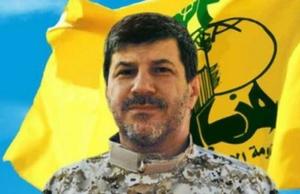TerrorismHezbollah No. 3 commander gunned down in Beirut
Hassan al-Laqees, regarded as the third or fourth most important leader of Hezbollah, was gunned down outside his home in Beirut last night. The Shi’a group blamed Israel for the assassination and warned that Israel would pay a price for the killing. Al-Laqees, who had served in various capacities in Hezbollah since the 1980s, was regarded by Western intelligence services as a brilliant technology and logistics officer. He was in charge of the organization’s arms development and acquisition, technology, and communication, and was heavily involved in operations. Analysts compare the operational blow to Hezbollah from al-Laqees’s assassination to the setback the organization suffered when Israeli agent killed Imad Mughniyeh, the then-operation chief of Hezbollah, in a daring covert operation in Damascus on 12 February 2008.

Hassan al-Laqees, former leader of Hezbollah // Source: al-marsd.com
Hassan al-Laqees, regarded as the third or fourth most important leader of Hezbollah, was gunned down outside his home in Beirut last night. The Shi’a group blamed Israel for the assassination and warned that Israel would pay a price for the killing.
Al-Laqees was killed late Tuesday in the Hadath area of Beirut, a Shi’a neighborhood controlled by Hezbollah. In a clean and professional operation, three masked gunmen waited for him outside his home and one of them used handgun with a silencer to shoot him five times in the head and neck, before the three quietly disappearing into the night.
“The Israeli enemy is automatically held completely responsible for this heinous crime,” Hezbollah said in a statement.
Israeli Foreign Ministry spokesman Yigal Palmor denied that Israel was involved, the AP reported.
“Israel has nothing to do with this incident,” Palmor said. “These automatic accusations are an innate reflex with Hezbollah. They don’t need evidence, they don’t need facts, they just blame anything on Israel.”
Al-Laqees, who had served in various capacities in Hezbollah since the 1980s, was regarded by Western intelligence services as a brilliant technology and logistics officer. He was in charge of the organization’s arms development and acquisition, technology, and communication, and was heavily involved in operations.
He was the officer behind the acquisition by Hezbollah of tens of thousands of rockets and missiles, and was responsible for making these rockets and missiles more accurate. In the last two years he increased Hezbollah’s efforts to acquire UAVs, and was behind the organization’s plans to develop and build its own drones.
A few years ago Hezbollah came to the conviction that the Lebanese state bureaucracy was thoroughly penetrated by Israeli informers, and that, as a result, the organization’s communications were exposed. Under al-Laqees’s guidance, and with Iran’s money and engineering support, Hezbollah embarked on an ambitious effort to build its own private communication infrastructure and network which would bypass and be separated from the Lebanese state’s national communication system. The Lebanese government, viewing Hezbollah’s communication plan as one more step toward the disintegration Lebanon, objected. Hezbollah, driving home the point that it did not see itself obligated to listen to, let alone follow, what the Lebanese government said, sent thousands of its Shi’a militiamen to occupy central Beirut for a couple of days.
Hezbollah’s message was clear: it would allow the Lebanese government to remain a figurehead entity in Lebanon as long as it stayed out of Hezbollah’s way. If the government persisted, Hezbollah would not allow it even the meaningless role of a figurehead. The government understood the message, and withdrew its futile effort to block Hezbollah’s private communication infrastructure.
In the last three years, as the civil war in Syria has caused the disintegration of the Syrian state, al-Laqees was put in charge of efforts to move large quantities of advanced weapon systems from Syrian military depots to Lebanon, to make sure these systems remained in the hands of forces loyal to Iran. Since January 2013, the Israel Air Force has bombed military convoys and arms depots in Syria on at least six occasions when Israeli intelligence concluded that certain advanced weapons were about to be shipped to Hezbollah.
In his capacity as head of Hezbollah’s arms and logistics branches, al-Laqees was the liaison between the organization and Iran.
Analysts compare the operational blow to Hezbollah from al-Laqees’s assassination to the setback the organization suffered when Israeli agent killed Imad Mughniyeh, the then-operation chief of Hezbollah, in a daring covert operation in Damascus on 12 February 2008.
It is not clear whether Al-Laqees was killed by Israeli agents. The Washington Post notes that there have been increased tensions in Lebanon between Shiite Hezbollah and Sunni extremist groups which oppose the Shi’a militia’s role in the civil war in neighboring Syria, where Hezbollah has sent thousands of fighters to support President Bashar al-Assad.
Sunni supporters of the anti-Assad rebels have targeted Shi’a strongholds in Lebanon, and last month exploded two car bombs outside the Iranian embassy in the city.
The Post reports that a little-known group called the Ahrar al-Sunna Baalbek Brigade claimed responsibility in a Twitter post, but the claim could not be verified.
